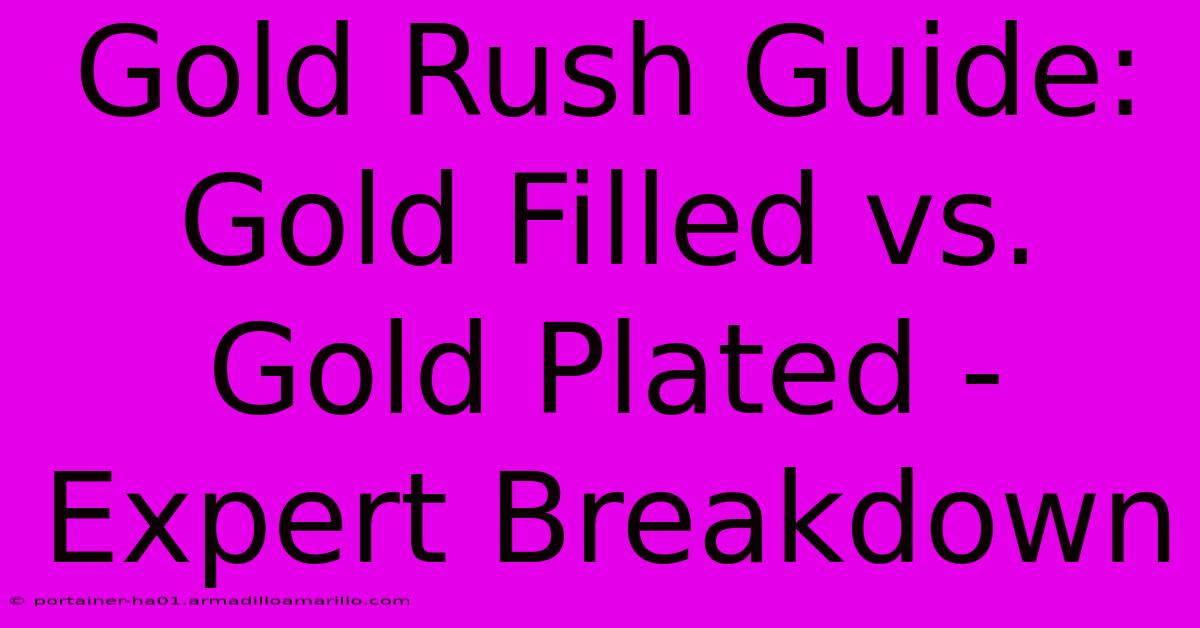Gold Rush Guide: Gold Filled Vs. Gold Plated - Expert Breakdown

Table of Contents
Gold Rush Guide: Gold Filled vs. Gold Plated - Expert Breakdown
The allure of gold is undeniable. Its rich history, lustrous shine, and perceived value make it a highly sought-after material in jewelry and accessories. But when you're shopping for gold items, you'll often encounter terms like "gold-filled" and "gold-plated," leaving you wondering: what's the difference? This guide offers an expert breakdown, helping you navigate the world of gold and make informed purchasing decisions.
Understanding the Key Differences: Gold Filled vs. Gold Plated
Both gold-filled and gold-plated jewelry offer a touch of gold's elegance at a more affordable price point than solid gold. However, their construction and durability differ significantly. This difference stems from how the gold layer is applied to the base metal.
Gold Filled: A Superior Layer
Gold-filled jewelry is created by bonding a layer of karat gold to a base metal, typically brass or sterling silver, through intense heat and pressure. The gold layer is mechanically bonded, not just superficially coated. This process results in a thicker layer of gold than gold plating, making gold-filled jewelry significantly more durable and long-lasting.
- Key Characteristics:
- Thickness: A considerably thicker gold layer (typically 1/20th of the total weight or more).
- Durability: More resistant to wear and tear; the gold layer lasts much longer.
- Appearance: Maintains its gold appearance for years with proper care.
- Cost: More expensive than gold-plated jewelry but less than solid gold.
Gold Plated: A Thinner Coating
Gold-plated jewelry involves a thin layer of gold electroplated onto a base metal. The process uses an electrical current to deposit a layer of gold onto the surface. This layer is considerably thinner than gold-filled jewelry.
- Key Characteristics:
- Thickness: A very thin layer of gold.
- Durability: More prone to scratching, chipping, and fading; the gold layer wears off quickly with regular use.
- Appearance: The gold appearance can fade or wear off relatively quickly, revealing the base metal underneath.
- Cost: The most affordable option.
The Gold Standard: A Comparison Table
| Feature | Gold Filled | Gold Plated |
|---|---|---|
| Gold Layer | Thick (1/20th or more of total weight) | Very thin |
| Durability | High | Low |
| Longevity | Long-lasting | Short-lasting |
| Appearance | Maintains appearance for years | Can fade or wear off quickly |
| Cost | More expensive than gold-plated | Least expensive |
| Ideal For | Everyday wear, heirloom pieces | Occasional wear, fashion jewelry |
Choosing the Right Gold for You
The best choice depends on your budget, desired lifespan, and intended use.
-
Choose gold-filled if you want a piece that looks and feels luxurious and will last for years, even with daily wear. It's a great compromise between solid gold and affordability.
-
Choose gold-plated if you're looking for a temporary, budget-friendly accessory. Understand that it's not designed for daily wear and will likely lose its gold finish over time.
Caring for Your Gold Jewelry
Regardless of whether you have gold-filled or gold-plated jewelry, proper care will prolong its lifespan and maintain its shine:
- Avoid harsh chemicals: Remove jewelry before showering, swimming, or using cleaning products.
- Store properly: Keep your jewelry in a soft pouch or jewelry box to prevent scratching.
- Clean gently: Use a soft cloth to gently wipe away dust and dirt.
By understanding the differences between gold-filled and gold-plated jewelry, you can make an informed decision that fits your style and budget, ensuring you get the most out of your gold investment. Remember, knowing the nuances of gold types allows you to appreciate the true value and craftsmanship of your chosen piece.

Thank you for visiting our website wich cover about Gold Rush Guide: Gold Filled Vs. Gold Plated - Expert Breakdown. We hope the information provided has been useful to you. Feel free to contact us if you have any questions or need further assistance. See you next time and dont miss to bookmark.
Featured Posts
-
The Vba Word Redaction Toolkit Empowering You With Automated Data Security
Feb 06, 2025
-
Field Goal Of Funny Names The Greatest Football Player Names That Will Have You Goal Digging For More
Feb 06, 2025
-
Game Changer For Gamers Conquer Multiple Monitors With Hdmi Splitter
Feb 06, 2025
-
Unlock The Secrets Of Tt Intrhpses Pr Trl Cnd Db Your Ultimate Guide
Feb 06, 2025
-
Say Goodbye To Sensitive Data Breaches The Ultimate Guide To Vba Redaction
Feb 06, 2025
